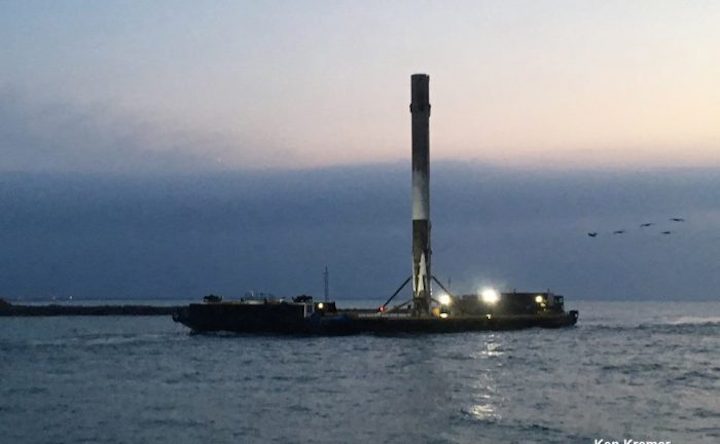5.04.2017

World’s first reflown rocket booster - the SpaceX Falcon 9 first stage - sails back into Port Canaveral, FL just before sunrise atop OCISLY droneship on which it landed 9 minutes after March 30, 2017 liftoff from KSC with SES-10 telecomsat - as seen entering channels mouth trailing a flock of birds from Jetty Park pier on April 4, 2017. Credit: Ken Kremer
WORLDS’ 1ST RECYCLED BOOSTER FROM SPACEX SAILS SERENELY AT SUNRISE INTO PORT CANAVERAL
PORT CANAVERAL/KENNEDY SPACE CENTER, FL – Basking in the sunrise glow, the world’s first recycled booster – namely a SpaceX Falcon 9 – sailed serenely into Port Canaveral this morning, Tuesday, April 4, atop the tiny droneship on which it soft landed shortly after launching on March 30 for an unprecedented second time.
Shortly before sunrise, SpaceX’s recovered Falcon 9 first stage triumphantly arrived on Tuesday at the mouth of Port Canaveral and the public pier at Jetty Park around 7 am – greeted by excited onlookers, media and space buffs eager to be an eyewitness to the first rocket to launch and land two times fully intact !
The Falcon 9 standing proudly erect on the football field sized OCISLY droneship landing pad was towed into port by the Elsbeth III in the wee morning hours around 7 am. The ships made their way majestically along the channel westwards until reaching the docking port.
The milestone SpaceX mission to refly the first ever ‘used rocket’ blasted off right on time at the opening of the dinnertime launch window on Thursday, March 30, at 6:27 p.m. EDT.
The used two stage 229-foot-tall (70-meter) rocket carried the SES-10 telecommunications payload to orbit using a ‘Flight-Proven’ Falcon 9 rocket from seaside Launch Complex 39A at NASA’s Kennedy Space Center (KSC) in Florida.
After the 156 foot tall first stage booster completed its primary mission task, SpaceX engineers successfully guided it to a second landing on the tiny Of Course I Still Love You – OCISLY – drone ship for a soft touchdown some eight and a half minutes after liftoff.
“This is a huge revolution in spaceflight,” billionaire SpaceX CEO and Chief Designer Elon Musk told reporters at the post launch briefing at the Kennedy Space Center press site, barely an hour after liftoff.
Musk’s goal is to drastically reduce the cost of spaceflight so that it will one day lead to a ‘City on Mars’.
Recovered and twice flown and landed SpaceX Falcon 9 first stage stands chained to the deck of the OCISLY droneship as seen being towed into the mouth of Port Canaveral channels from Jetty Park pier on April 4, 2017. It launched on March 30, 2017 from KSC ansd delivered SES-10 telecomsat to GTO. Credit: Ken Kremer/Kenkremer.com
OCISLY had left Port Canaveral several days ahead of the March 30 launch and was prepositioned in the Atlantic Ocean some 400 miles (600 km) off the US East coast, just waiting for the boosters 2nd history making approach and pinpoint propulsive soft landing.
This recycled Falcon 9 first stage booster had initially launched a year ago in April 2016 for NASA on the SpaceX Dragon CRS-8 resupply mission to the International Space Station (ISS) under contract for the space agency.
Check out this video after port arrival.
Video Caption: The booster looks ready for another flight after arriving in to Port Canaveral, FL on 4 April 2017 and launching/landing from KSC on 30 March 2017. Elon Musk has said it will be put on display in Florida. This is a total game changer for the rocket industry. Credit:USLaunchReport
After making its way picturesquely through Port Canaveral channel, the droneship was docked, Workers soon attached a metal cap to the top of the first stage.
Next they removed the restraining chains fastening the booster to the deck. Next they hoisted it off the droneship with a work crane and transported it onto a work pedestal on the ground for further processing.
By late evening I observed that the workers were still busily operating on the booster. They were welding the metal cap to the top of the booster. All 4 landing legs were still attached as of 10 p.m. EDT on Tuesday, April 4.
The legs will soon be detached so the booster can be rotated horizontal and trucked back to the huge hangar at pad 39A.
Quelle: UT
